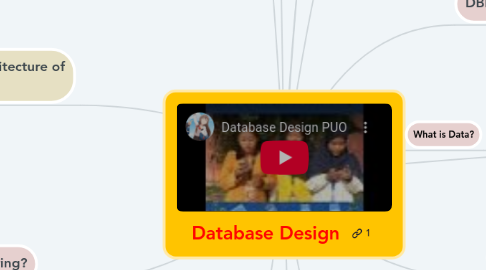
1. Client-Server Architecture of DBMS
1.1. A network architecture in which each computer or process on the network is either a client or a server.
2. Categories of DBMS
2.1. 1.Desktop Databases
2.2. Desktop databases offer an inexpensive, simple solution to many less complex data storage and manipulation requirements.
2.3. Examples - Microsoft Access, FoxPro,FileMaker Pro ,Paradox and Lotus Approach are the major players.
2.3.1. BENEFITS
2.3.1.1. a) Inexpensive.
2.3.1.2. b) User-friendly.
2.3.1.3. c) Offer web solutions.
2.4. 2.Server Databases
2.4.1. Offer organizations the ability to manage large amounts of data efficiently and in manner that enables many users to access and update the data simultaneously.
2.4.2. Example - Microsoft SQL Server ,Oracle and IBM DB2 .
2.4.2.1. BENEFITS
2.4.2.1.1. a) Flexibility - can handle just about any data management problem . Available for multiple operating system .
2.4.2.1.2. b) Powerful performance - can manage multiple high-speed processors, clustered servers, high bandwidth connectivity and fault tolerant storage technology .
2.4.2.1.3. c) Scalability - able to garcefully handle a rapidly expanding amount of users and/or data .
3. Three-Schema Architecture of DBMS
3.1. 1. External Level / Schema
3.1.1. The user's view of the database
3.1.2. Consists of a number of different external views of the DB
3.1.3. Describes part of the DB for particular group of users
3.2. 2. Conceptual Level / Schema
3.2.1. The logical structure of the entire database as seen by DBA
3.2.2. What data is stored in the database
3.3. 3. Internal Level / Schema
3.3.1. Physical representation of the DB on the computer
3.3.2. How the data is stored in the database
3.3.3. The relationships among the data
4. What is Data Sharing?
4.1. The ability to share the same data resource with multiple applications or users.
5. Data Model
5.1. Hierarchical Database
5.1.1. Develop to manage large amount of data
5.1.2. Assume data relationships are hierarchical
5.1.3. One to many (1:M) relationship
5.1.4. Represented by an upside down tree
5.2. Network Database
5.2.1. Similar to Hierarchical Model. Records linked by pointer.
5.2.2. Composed of sets
5.2.3. Many to Many (M:N) relationships
5.3. Entity Relationship Model
5.3.1. Graphical representation of entities
5.3.2. Based on Entity, Attributes & Relationship
5.3.3. Complements the relational data concept
5.4. Relational Database
5.4.1. Problem with legacy database systems
5.4.1.1. Required excessive effort to maintain.
5.4.1.2. hard to manipulate by end-users
6. What is Information?
6.1. Data that has been processed
6.2. Can be used to make decision
7. What is Database?
7.1. Collection of related data that is shared by the various categories of users to meet the requirements of an organization's information
8. Database Development Process
8.1. 1. Project identification
8.2. 2. Project Initiation and Planning
8.3. 3. Analysis
8.4. 4. Logical Design
8.5. 6. Implementation
8.6. 7. Maintenance
9. DBMS Usage Requirement
9.1. Store Data Efficiently
9.2. Maintains Data Easily
9.3. Combining The Data
9.4. User Accessible Catalog
9.5. Transaction Support
9.6. Concurrency Control Services
9.7. Recovery Services
10. What is Data?
10.1. Data are facts about object, thing, person, entity, event or anything similar to it
11. 5. Physical Design
12. Properties of Database
12.1. Completeness
12.2. Integrity
12.3. Flexibility
12.4. Efficiency
12.5. Usability (ease of use)
13. What is DBMS?
13.1. A software system that enables to define, create and maintain the database
14. Common Features of DBMS
14.1. Database Definition
14.1.1. To define entities, relationships, integrity, constrain and authorization.
14.2. Nonprocedural Access
14.2.1. Access data without complicated coding
14.3. Application Development
14.3.1. Graphical tools to develop menus, data entry forms, and report.
14.3.2. Data requirement for form and report.
14.4. Procedural Language
14.4.1. Combines nonprocedural access with full capabilities.
14.5. Transaction Processing
14.5.1. To prevent interference from simultaneous user. Recover lost data after failure.
14.6. Database Tuning
14.6.1. Tools to monitor and improve database perfomance
